Economic Analysis: The Effectiveness of Minimum Wage Legislation
VerifiedAdded on 2023/06/05
|9
|1673
|95
Homework Assignment
AI Summary
This economics assignment thoroughly examines the effectiveness of minimum wage legislation. It begins by defining minimum wage and identifying the national minimum wage in Australia. The assignment then delves into calculating equilibrium wage and quantity of unskilled laborers using supp...

Running Head: Minimum Wage
The Effectiveness of Minimum Wage Legislation
By (Name)
(Tutor)
(University)
(Date)
The Effectiveness of Minimum Wage Legislation
By (Name)
(Tutor)
(University)
(Date)
Paraphrase This Document
Need a fresh take? Get an instant paraphrase of this document with our AI Paraphraser
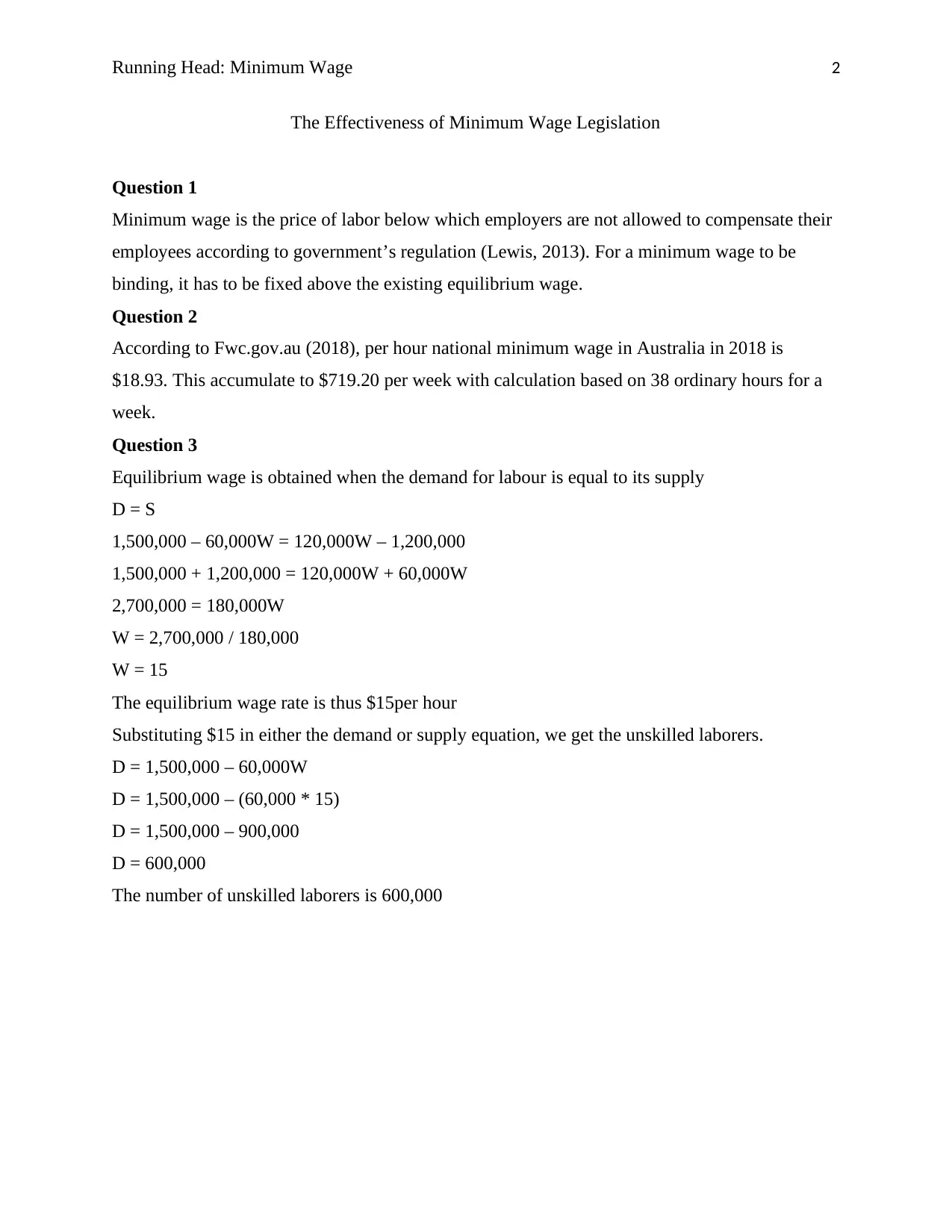
Running Head: Minimum Wage 2
The Effectiveness of Minimum Wage Legislation
Question 1
Minimum wage is the price of labor below which employers are not allowed to compensate their
employees according to government’s regulation (Lewis, 2013). For a minimum wage to be
binding, it has to be fixed above the existing equilibrium wage.
Question 2
According to Fwc.gov.au (2018), per hour national minimum wage in Australia in 2018 is
$18.93. This accumulate to $719.20 per week with calculation based on 38 ordinary hours for a
week.
Question 3
Equilibrium wage is obtained when the demand for labour is equal to its supply
D = S
1,500,000 – 60,000W = 120,000W – 1,200,000
1,500,000 + 1,200,000 = 120,000W + 60,000W
2,700,000 = 180,000W
W = 2,700,000 / 180,000
W = 15
The equilibrium wage rate is thus $15per hour
Substituting $15 in either the demand or supply equation, we get the unskilled laborers.
D = 1,500,000 – 60,000W
D = 1,500,000 – (60,000 * 15)
D = 1,500,000 – 900,000
D = 600,000
The number of unskilled laborers is 600,000
The Effectiveness of Minimum Wage Legislation
Question 1
Minimum wage is the price of labor below which employers are not allowed to compensate their
employees according to government’s regulation (Lewis, 2013). For a minimum wage to be
binding, it has to be fixed above the existing equilibrium wage.
Question 2
According to Fwc.gov.au (2018), per hour national minimum wage in Australia in 2018 is
$18.93. This accumulate to $719.20 per week with calculation based on 38 ordinary hours for a
week.
Question 3
Equilibrium wage is obtained when the demand for labour is equal to its supply
D = S
1,500,000 – 60,000W = 120,000W – 1,200,000
1,500,000 + 1,200,000 = 120,000W + 60,000W
2,700,000 = 180,000W
W = 2,700,000 / 180,000
W = 15
The equilibrium wage rate is thus $15per hour
Substituting $15 in either the demand or supply equation, we get the unskilled laborers.
D = 1,500,000 – 60,000W
D = 1,500,000 – (60,000 * 15)
D = 1,500,000 – 900,000
D = 600,000
The number of unskilled laborers is 600,000
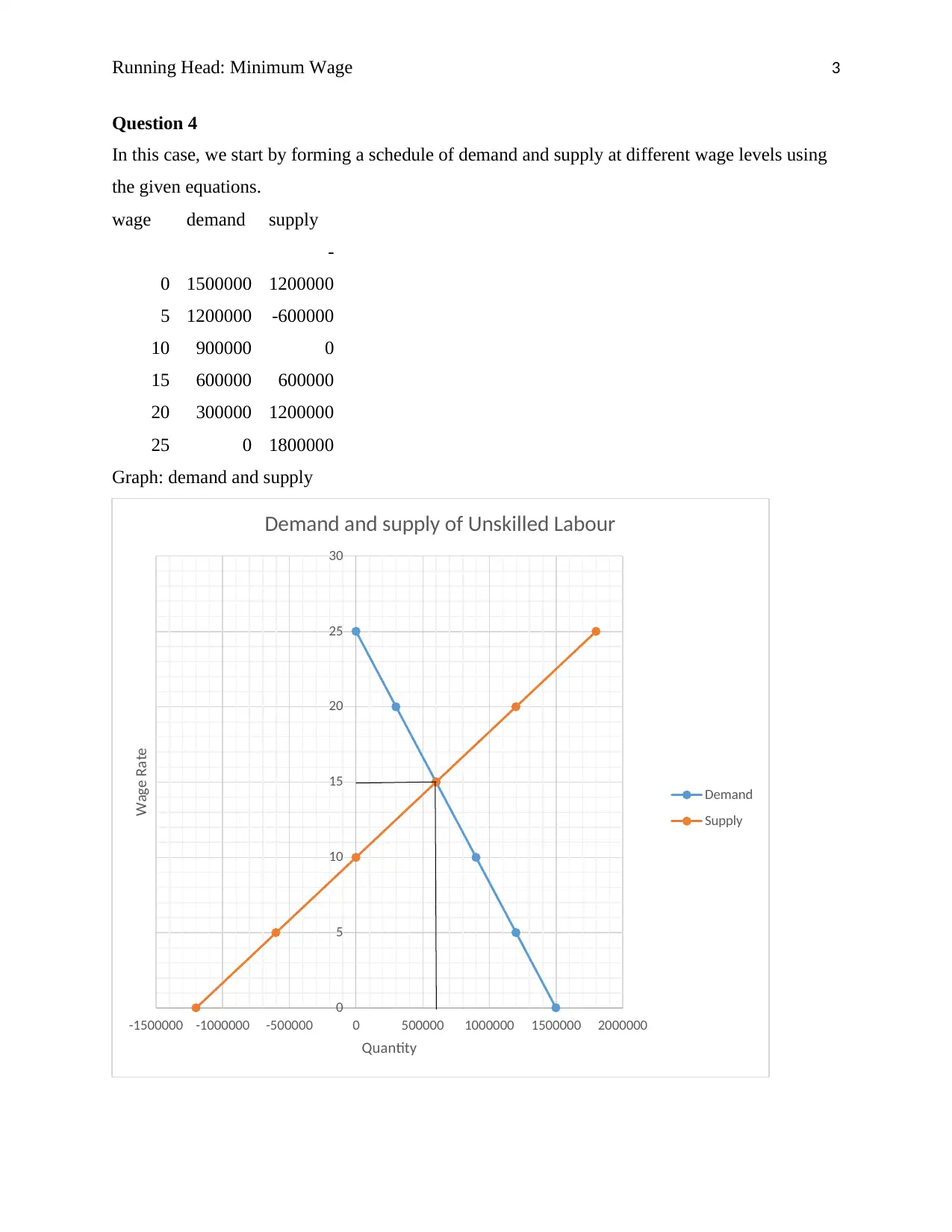
Running Head: Minimum Wage 3
Question 4
In this case, we start by forming a schedule of demand and supply at different wage levels using
the given equations.
wage demand supply
0 1500000
-
1200000
5 1200000 -600000
10 900000 0
15 600000 600000
20 300000 1200000
25 0 1800000
Graph: demand and supply
0
5
10
15
20
25
30
-1500000 -1000000 -500000 0 500000 1000000 1500000 2000000
Wage Rate
Quantity
Demand and supply of Unskilled Labour
Demand
Supply
Question 4
In this case, we start by forming a schedule of demand and supply at different wage levels using
the given equations.
wage demand supply
0 1500000
-
1200000
5 1200000 -600000
10 900000 0
15 600000 600000
20 300000 1200000
25 0 1800000
Graph: demand and supply
0
5
10
15
20
25
30
-1500000 -1000000 -500000 0 500000 1000000 1500000 2000000
Wage Rate
Quantity
Demand and supply of Unskilled Labour
Demand
Supply
⊘ This is a preview!⊘
Do you want full access?
Subscribe today to unlock all pages.

Trusted by 1+ million students worldwide
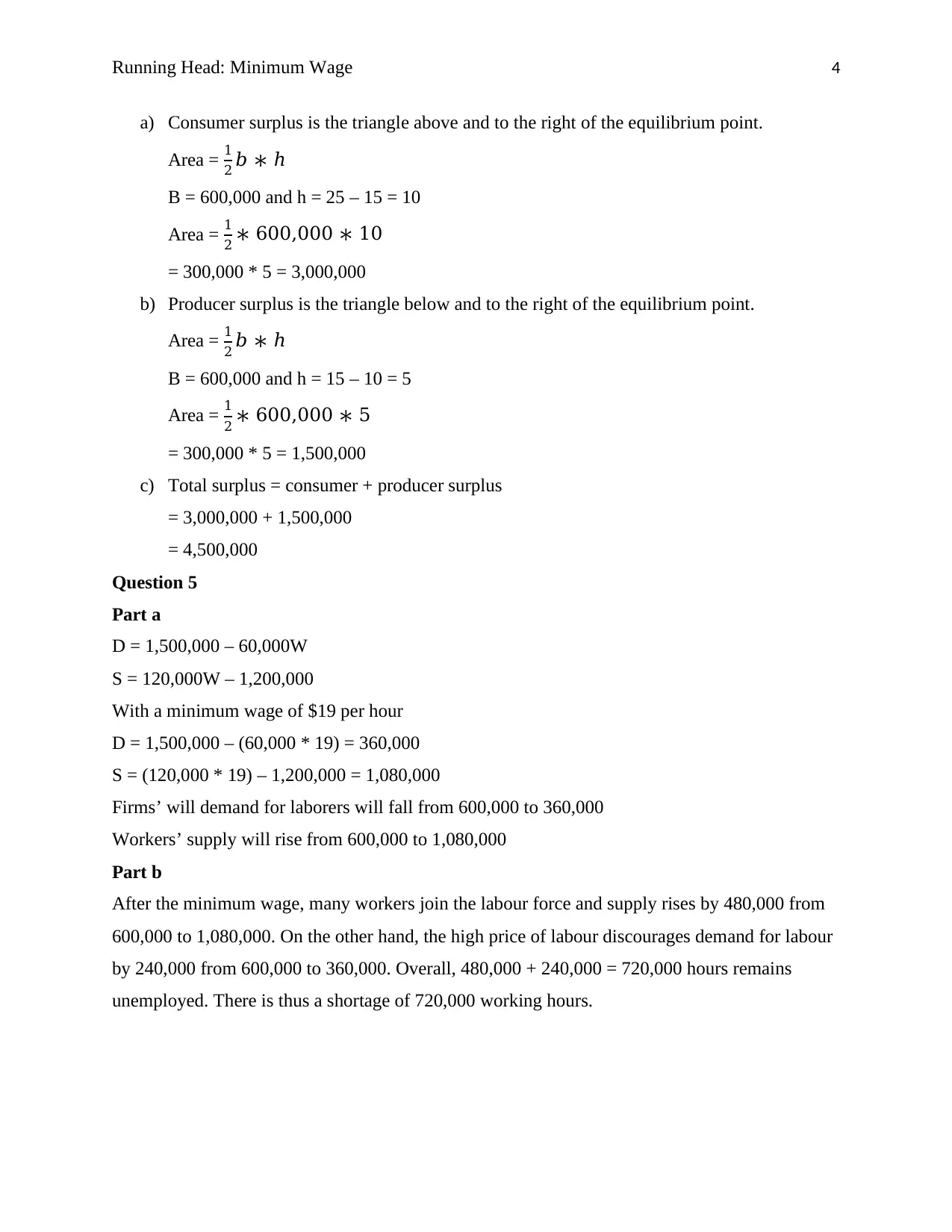
Running Head: Minimum Wage 4
a) Consumer surplus is the triangle above and to the right of the equilibrium point.
Area = 1
2 𝑏 ∗ ℎ
B = 600,000 and h = 25 – 15 = 10
Area = 1
2 ∗ 600,000 ∗ 10
= 300,000 * 5 = 3,000,000
b) Producer surplus is the triangle below and to the right of the equilibrium point.
Area = 1
2 𝑏 ∗ ℎ
B = 600,000 and h = 15 – 10 = 5
Area = 1
2 ∗ 600,000 ∗ 5
= 300,000 * 5 = 1,500,000
c) Total surplus = consumer + producer surplus
= 3,000,000 + 1,500,000
= 4,500,000
Question 5
Part a
D = 1,500,000 – 60,000W
S = 120,000W – 1,200,000
With a minimum wage of $19 per hour
D = 1,500,000 – (60,000 * 19) = 360,000
S = (120,000 * 19) – 1,200,000 = 1,080,000
Firms’ will demand for laborers will fall from 600,000 to 360,000
Workers’ supply will rise from 600,000 to 1,080,000
Part b
After the minimum wage, many workers join the labour force and supply rises by 480,000 from
600,000 to 1,080,000. On the other hand, the high price of labour discourages demand for labour
by 240,000 from 600,000 to 360,000. Overall, 480,000 + 240,000 = 720,000 hours remains
unemployed. There is thus a shortage of 720,000 working hours.
a) Consumer surplus is the triangle above and to the right of the equilibrium point.
Area = 1
2 𝑏 ∗ ℎ
B = 600,000 and h = 25 – 15 = 10
Area = 1
2 ∗ 600,000 ∗ 10
= 300,000 * 5 = 3,000,000
b) Producer surplus is the triangle below and to the right of the equilibrium point.
Area = 1
2 𝑏 ∗ ℎ
B = 600,000 and h = 15 – 10 = 5
Area = 1
2 ∗ 600,000 ∗ 5
= 300,000 * 5 = 1,500,000
c) Total surplus = consumer + producer surplus
= 3,000,000 + 1,500,000
= 4,500,000
Question 5
Part a
D = 1,500,000 – 60,000W
S = 120,000W – 1,200,000
With a minimum wage of $19 per hour
D = 1,500,000 – (60,000 * 19) = 360,000
S = (120,000 * 19) – 1,200,000 = 1,080,000
Firms’ will demand for laborers will fall from 600,000 to 360,000
Workers’ supply will rise from 600,000 to 1,080,000
Part b
After the minimum wage, many workers join the labour force and supply rises by 480,000 from
600,000 to 1,080,000. On the other hand, the high price of labour discourages demand for labour
by 240,000 from 600,000 to 360,000. Overall, 480,000 + 240,000 = 720,000 hours remains
unemployed. There is thus a shortage of 720,000 working hours.
Paraphrase This Document
Need a fresh take? Get an instant paraphrase of this document with our AI Paraphraser
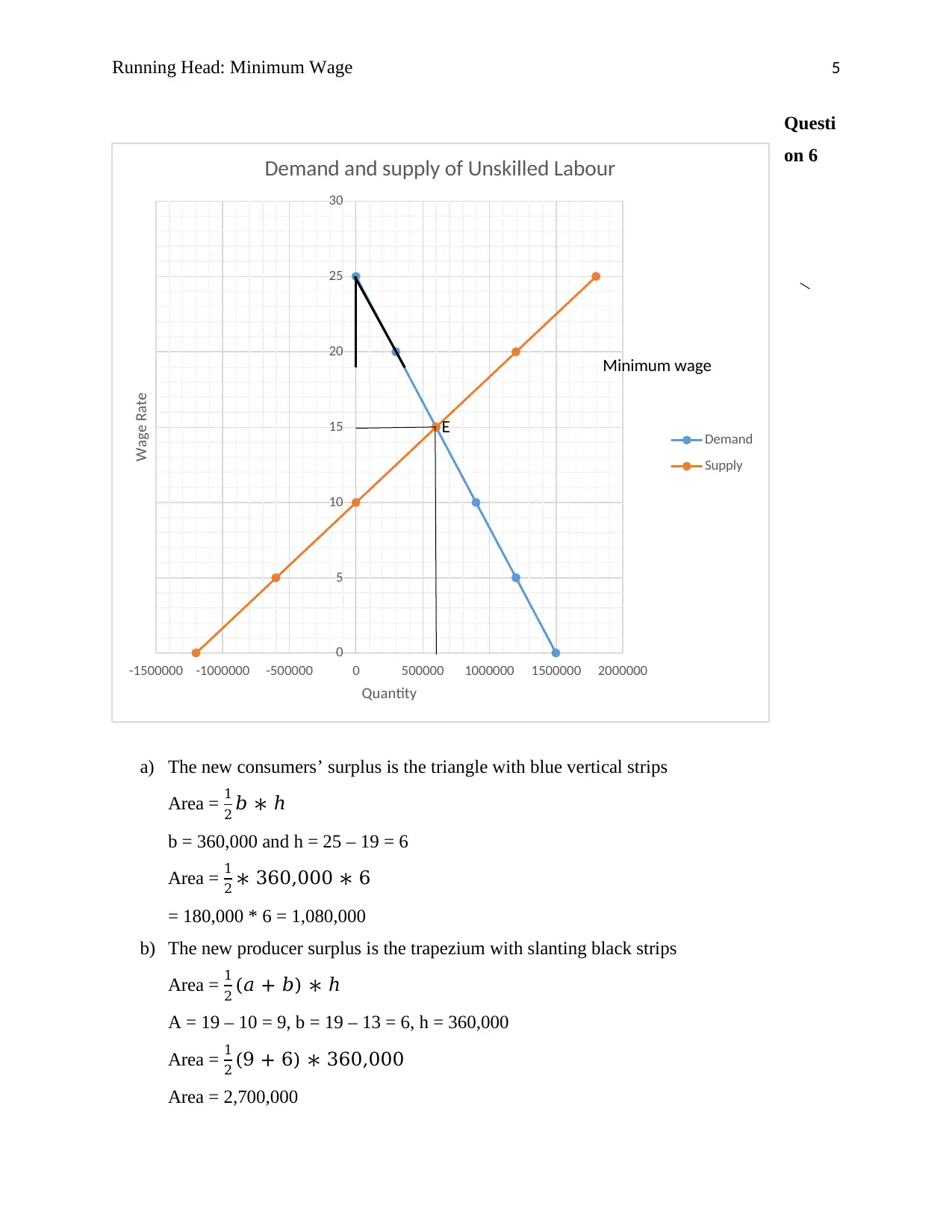
Running Head: Minimum Wage 5
Questi
on 6
a) The new consumers’ surplus is the triangle with blue vertical strips
Area = 1
2 𝑏 ∗ ℎ
b = 360,000 and h = 25 – 19 = 6
Area = 1
2 ∗ 360,000 ∗ 6
= 180,000 * 6 = 1,080,000
b) The new producer surplus is the trapezium with slanting black strips
Area = 1
2 (𝑎 + 𝑏) ∗ ℎ
A = 19 – 10 = 9, b = 19 – 13 = 6, h = 360,000
Area = 1
2 (9 + 6) ∗ 360,000
Area = 2,700,000
0
5
10
15
20
25
30
-1500000 -1000000 -500000 0 500000 1000000 1500000 2000000
Wage Rate
Quantity
Demand and supply of Unskilled Labour
Demand
Supply
Minimum wage
E
Questi
on 6
a) The new consumers’ surplus is the triangle with blue vertical strips
Area = 1
2 𝑏 ∗ ℎ
b = 360,000 and h = 25 – 19 = 6
Area = 1
2 ∗ 360,000 ∗ 6
= 180,000 * 6 = 1,080,000
b) The new producer surplus is the trapezium with slanting black strips
Area = 1
2 (𝑎 + 𝑏) ∗ ℎ
A = 19 – 10 = 9, b = 19 – 13 = 6, h = 360,000
Area = 1
2 (9 + 6) ∗ 360,000
Area = 2,700,000
0
5
10
15
20
25
30
-1500000 -1000000 -500000 0 500000 1000000 1500000 2000000
Wage Rate
Quantity
Demand and supply of Unskilled Labour
Demand
Supply
Minimum wage
E

Running Head: Minimum Wage 6
c) New total surplus
= 1,080,000 + 2,700,000
= 3,780,000
d) Resources lost
It’s the triangle with green horizontal strips
Area = 1
2 𝑏 ∗ ℎ
b = 19 -13 = 6 and h = 600,000 – 360,000 = 240,000
Area = 1
2 ∗ 6 ∗ 240,000
= 3*240,000 = 720,000
e) Deadweight loss
It’s the triangle with green horizontal strips
Area = 1
2 𝑏 ∗ ℎ
b = 19 -13 = 6 and h = 600,000 – 360,000 = 240,000
Area = 1
2 ∗ 6 ∗ 240,000
= 3*240,000 = 720,000
Question 7
i) Firms are worse off because they are not able to hire many workers due to high costs
(wages).
ii) Workers are better off since they have increased revenue to improve their living
standards.
iii) The society is worse off since the unemployment rate goes up.
Question 8
i) Consumer surplus
It’s equal to the new consumer surplus = 1,080,000
ii) Producer surplus
It’s equal to the new producer surplus + deadweight loss
= 2,700,000 + 720,000 = 3,420,000
iii) Total surplus = 1,080,000 + 3,420,000 = 4,500,000
iv) Deadweight loss = 0
c) New total surplus
= 1,080,000 + 2,700,000
= 3,780,000
d) Resources lost
It’s the triangle with green horizontal strips
Area = 1
2 𝑏 ∗ ℎ
b = 19 -13 = 6 and h = 600,000 – 360,000 = 240,000
Area = 1
2 ∗ 6 ∗ 240,000
= 3*240,000 = 720,000
e) Deadweight loss
It’s the triangle with green horizontal strips
Area = 1
2 𝑏 ∗ ℎ
b = 19 -13 = 6 and h = 600,000 – 360,000 = 240,000
Area = 1
2 ∗ 6 ∗ 240,000
= 3*240,000 = 720,000
Question 7
i) Firms are worse off because they are not able to hire many workers due to high costs
(wages).
ii) Workers are better off since they have increased revenue to improve their living
standards.
iii) The society is worse off since the unemployment rate goes up.
Question 8
i) Consumer surplus
It’s equal to the new consumer surplus = 1,080,000
ii) Producer surplus
It’s equal to the new producer surplus + deadweight loss
= 2,700,000 + 720,000 = 3,420,000
iii) Total surplus = 1,080,000 + 3,420,000 = 4,500,000
iv) Deadweight loss = 0
⊘ This is a preview!⊘
Do you want full access?
Subscribe today to unlock all pages.

Trusted by 1+ million students worldwide

Running Head: Minimum Wage 7
Question 9
The conclusion reported on question 7 does not change after the recalculation because firms are
still worse off, the workers are more better off, and the society is still worse off because it’s not
able to raise the employment rate.
Question 10
Minimum wage introduction is not ethically justified. This is because it does not consider
the loss of jobs to some initially employed workers. There are many workers who lose their jobs
whenever minimum wage is imposed because it raises the costs of production. Furthermore,
higher wages encourage persons that were not in the labour force to join it so as to receive the
higher wages. This makes the situation of unemployment a big challenge as there are more
unemployed people than there were before (those who lost their jobs and those who are
encouraged to join the labour force and also those who were still unemployed before the
minimum wage. The deadweight loss that results from its imposition represents a loss of
allocative efficiency which the government is obliged to promote. This policy could only be
appropriate if the government promises to subsidize the surplus that results from the minimum
wage imposition, otherwise no allocative efficiency could be achieved.
Question 11
In the perspective of improving the living standard of unskilled workers, the introduction
of minimum wage is still not ethically justified. Because some firms under compensate their
employees making them works for long but doesn’t offer a fair compensation for the same, the
government intervenes by imposing the minimum wage. Its intention is to ensure that workers
receive a higher wage that could help them purchase an extra bundle of good or services that
would interpret to better living standards. However, the living standards are only improved for
the workers who are lucky to maintain their jobs, and whom previous compensation were lower
(Belman and wolfson, 2014). The minimum wage does not take into consideration what may
happen to workers whose compensation was even higher than the minimum wage; firms may
decide to cut their compensation for their workers so as to improve profits by paying them the
minimum wage. This again would make the living standards of some to be worse off. It only
increases poverty level in an economy in the name of improving the living standards of a few.
Question 9
The conclusion reported on question 7 does not change after the recalculation because firms are
still worse off, the workers are more better off, and the society is still worse off because it’s not
able to raise the employment rate.
Question 10
Minimum wage introduction is not ethically justified. This is because it does not consider
the loss of jobs to some initially employed workers. There are many workers who lose their jobs
whenever minimum wage is imposed because it raises the costs of production. Furthermore,
higher wages encourage persons that were not in the labour force to join it so as to receive the
higher wages. This makes the situation of unemployment a big challenge as there are more
unemployed people than there were before (those who lost their jobs and those who are
encouraged to join the labour force and also those who were still unemployed before the
minimum wage. The deadweight loss that results from its imposition represents a loss of
allocative efficiency which the government is obliged to promote. This policy could only be
appropriate if the government promises to subsidize the surplus that results from the minimum
wage imposition, otherwise no allocative efficiency could be achieved.
Question 11
In the perspective of improving the living standard of unskilled workers, the introduction
of minimum wage is still not ethically justified. Because some firms under compensate their
employees making them works for long but doesn’t offer a fair compensation for the same, the
government intervenes by imposing the minimum wage. Its intention is to ensure that workers
receive a higher wage that could help them purchase an extra bundle of good or services that
would interpret to better living standards. However, the living standards are only improved for
the workers who are lucky to maintain their jobs, and whom previous compensation were lower
(Belman and wolfson, 2014). The minimum wage does not take into consideration what may
happen to workers whose compensation was even higher than the minimum wage; firms may
decide to cut their compensation for their workers so as to improve profits by paying them the
minimum wage. This again would make the living standards of some to be worse off. It only
increases poverty level in an economy in the name of improving the living standards of a few.
Paraphrase This Document
Need a fresh take? Get an instant paraphrase of this document with our AI Paraphraser
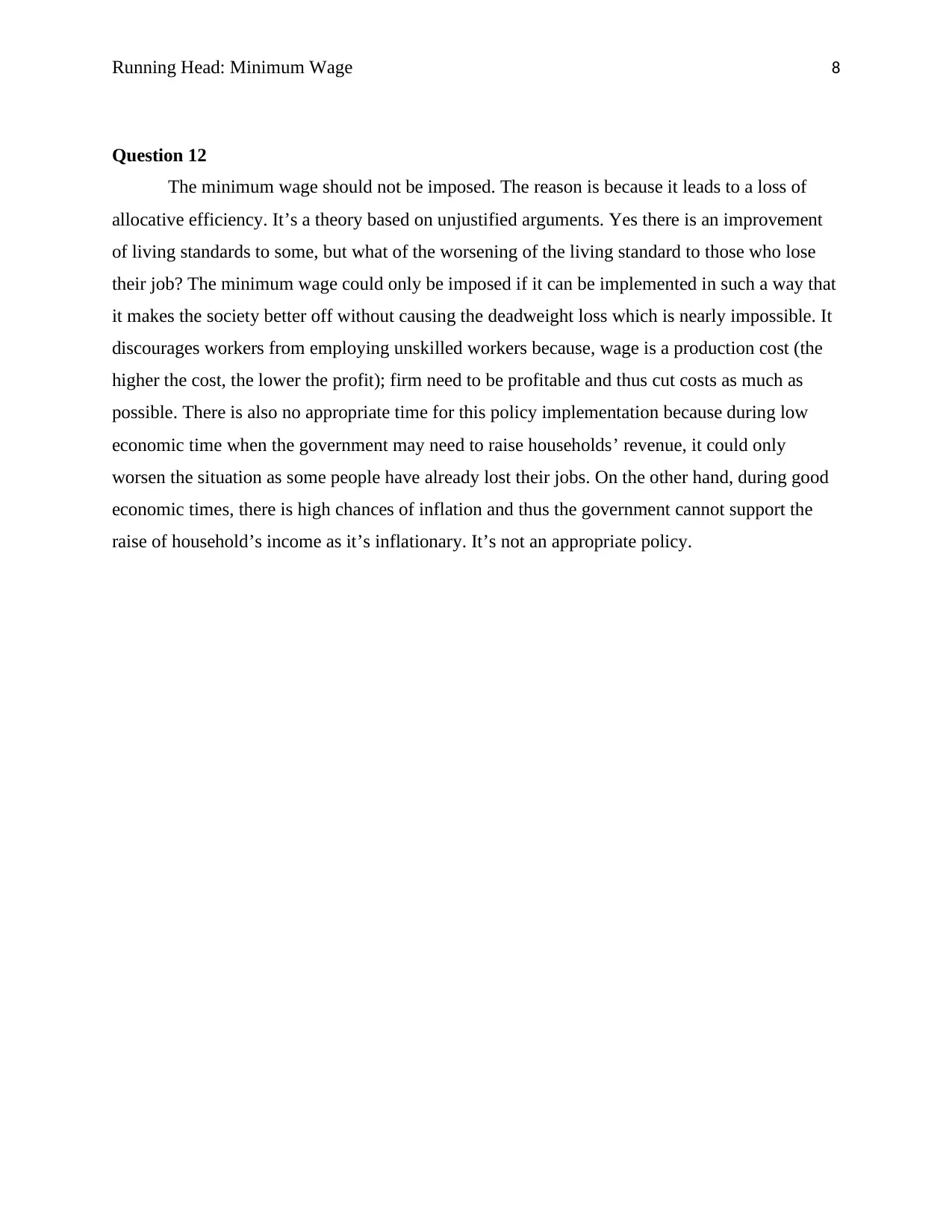
Running Head: Minimum Wage 8
Question 12
The minimum wage should not be imposed. The reason is because it leads to a loss of
allocative efficiency. It’s a theory based on unjustified arguments. Yes there is an improvement
of living standards to some, but what of the worsening of the living standard to those who lose
their job? The minimum wage could only be imposed if it can be implemented in such a way that
it makes the society better off without causing the deadweight loss which is nearly impossible. It
discourages workers from employing unskilled workers because, wage is a production cost (the
higher the cost, the lower the profit); firm need to be profitable and thus cut costs as much as
possible. There is also no appropriate time for this policy implementation because during low
economic time when the government may need to raise households’ revenue, it could only
worsen the situation as some people have already lost their jobs. On the other hand, during good
economic times, there is high chances of inflation and thus the government cannot support the
raise of household’s income as it’s inflationary. It’s not an appropriate policy.
Question 12
The minimum wage should not be imposed. The reason is because it leads to a loss of
allocative efficiency. It’s a theory based on unjustified arguments. Yes there is an improvement
of living standards to some, but what of the worsening of the living standard to those who lose
their job? The minimum wage could only be imposed if it can be implemented in such a way that
it makes the society better off without causing the deadweight loss which is nearly impossible. It
discourages workers from employing unskilled workers because, wage is a production cost (the
higher the cost, the lower the profit); firm need to be profitable and thus cut costs as much as
possible. There is also no appropriate time for this policy implementation because during low
economic time when the government may need to raise households’ revenue, it could only
worsen the situation as some people have already lost their jobs. On the other hand, during good
economic times, there is high chances of inflation and thus the government cannot support the
raise of household’s income as it’s inflationary. It’s not an appropriate policy.
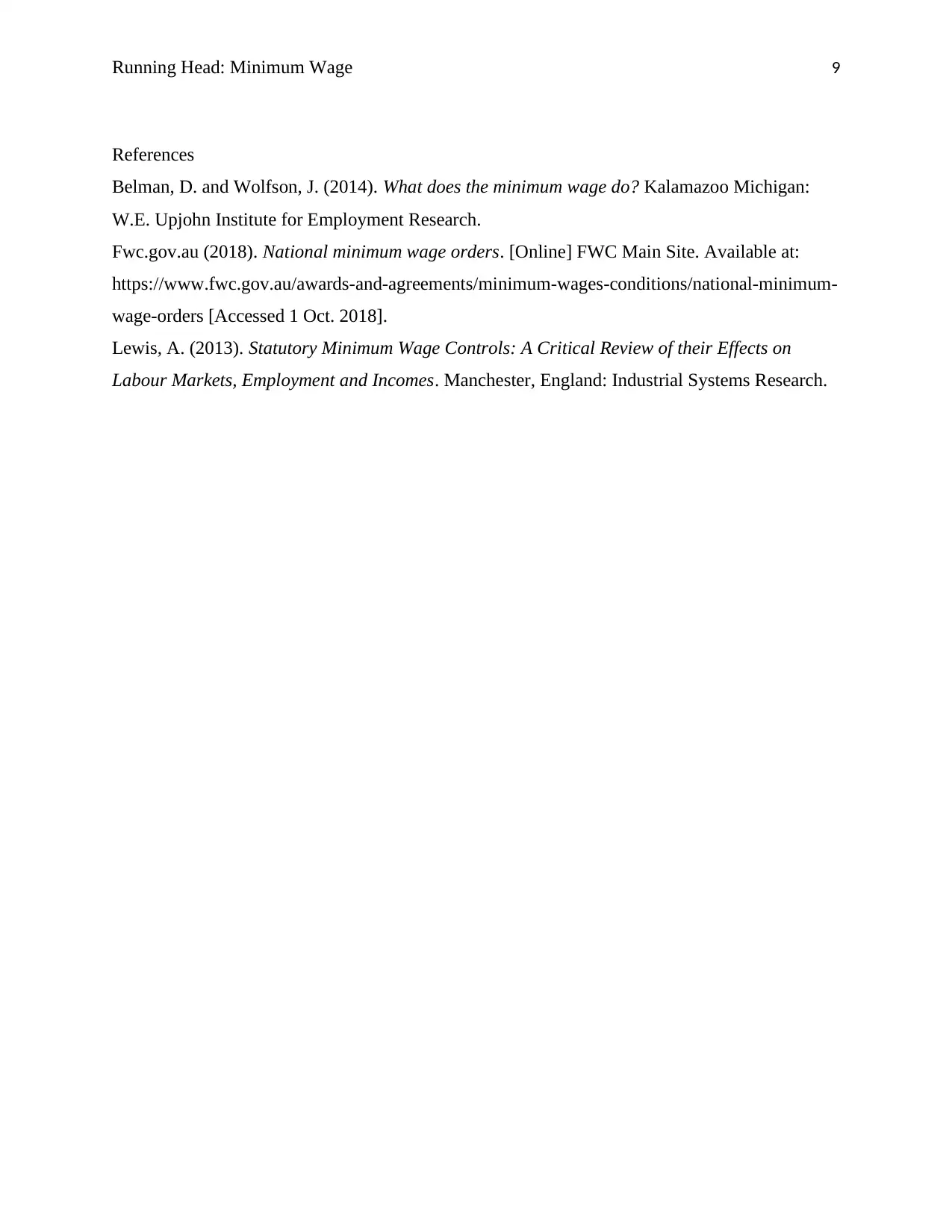
Running Head: Minimum Wage 9
References
Belman, D. and Wolfson, J. (2014). What does the minimum wage do? Kalamazoo Michigan:
W.E. Upjohn Institute for Employment Research.
Fwc.gov.au (2018). National minimum wage orders. [Online] FWC Main Site. Available at:
https://www.fwc.gov.au/awards-and-agreements/minimum-wages-conditions/national-minimum-
wage-orders [Accessed 1 Oct. 2018].
Lewis, A. (2013). Statutory Minimum Wage Controls: A Critical Review of their Effects on
Labour Markets, Employment and Incomes. Manchester, England: Industrial Systems Research.
References
Belman, D. and Wolfson, J. (2014). What does the minimum wage do? Kalamazoo Michigan:
W.E. Upjohn Institute for Employment Research.
Fwc.gov.au (2018). National minimum wage orders. [Online] FWC Main Site. Available at:
https://www.fwc.gov.au/awards-and-agreements/minimum-wages-conditions/national-minimum-
wage-orders [Accessed 1 Oct. 2018].
Lewis, A. (2013). Statutory Minimum Wage Controls: A Critical Review of their Effects on
Labour Markets, Employment and Incomes. Manchester, England: Industrial Systems Research.
⊘ This is a preview!⊘
Do you want full access?
Subscribe today to unlock all pages.

Trusted by 1+ million students worldwide
1 out of 9
Related Documents
Your All-in-One AI-Powered Toolkit for Academic Success.
+13062052269
info@desklib.com
Available 24*7 on WhatsApp / Email
![[object Object]](/_next/static/media/star-bottom.7253800d.svg)
Unlock your academic potential
© 2024 | Zucol Services PVT LTD | All rights reserved.




